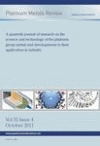-
oa Plastic Deformation of Polycrystalline Iridium at Room Temperature
- Source: Platinum Metals Review, Volume 53, Issue 3, Jul 2009, p. 138 - 146
Abstract
Defect structure and its relationship with deformation behaviour at room temperature of iridium, the sole refractory face centred cubic (f.c.c.) metal, are discussed. Small angle boundaries and pile-ups of curvilinear dislocation segments are the main features of dislocation structure in polycrystalline iridium at room temperature, while homogeneously distributed rectilinear dislocation segments were the main element of defect structure of iridium single crystals at the same conditions. Small angle boundaries and pile-ups of curvilinear dislocation segments are formed in iridium single crystals under mechanical treatment at elevated temperatures (≥ 800°C) only. The evolution of defect structure in polycrystalline iridium and other f.c.c. metals under room temperature deformation occurs by the same process: accumulation of dislocations in the matrix leads to the appearance of both new sub-grains and new grains up to the fine grain (nanocrystalline) structure. Neither single straight dislocations nor their pile-ups are observed in iridium at room temperature if small angle boundaries have been formed. This feature may be considered as the reason why polycrystalline iridium demonstrates advanced necking (high localised plasticity) and small total elongation.


